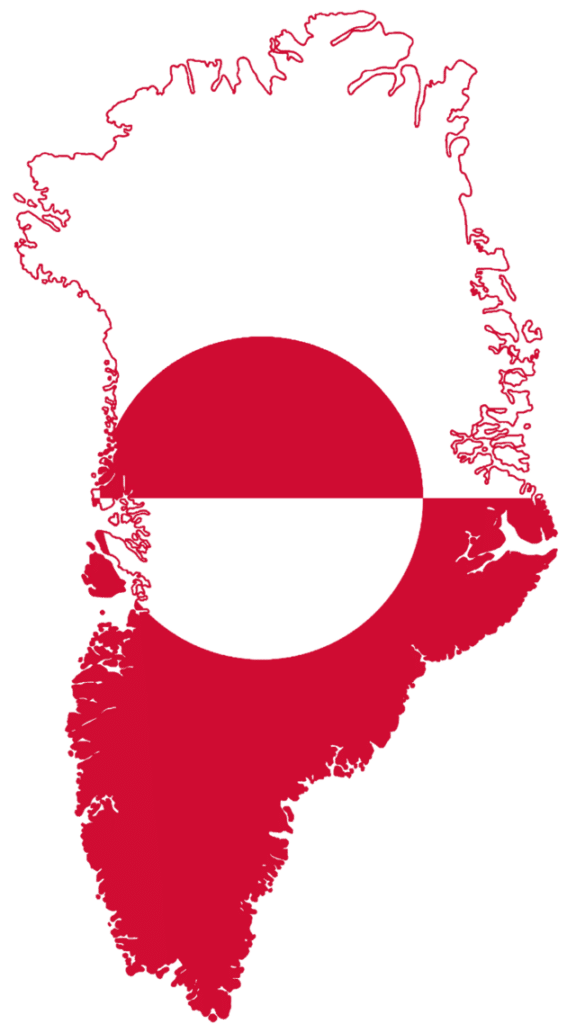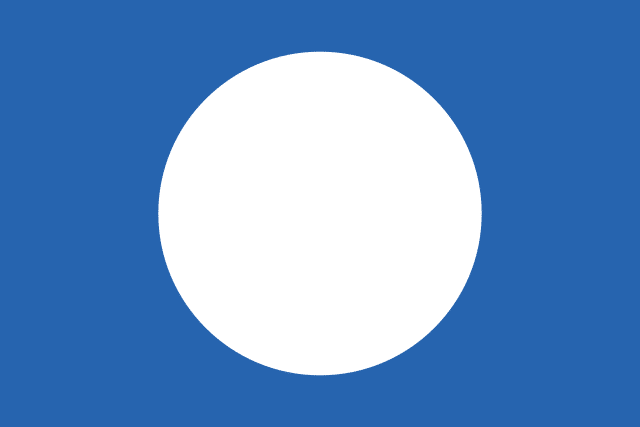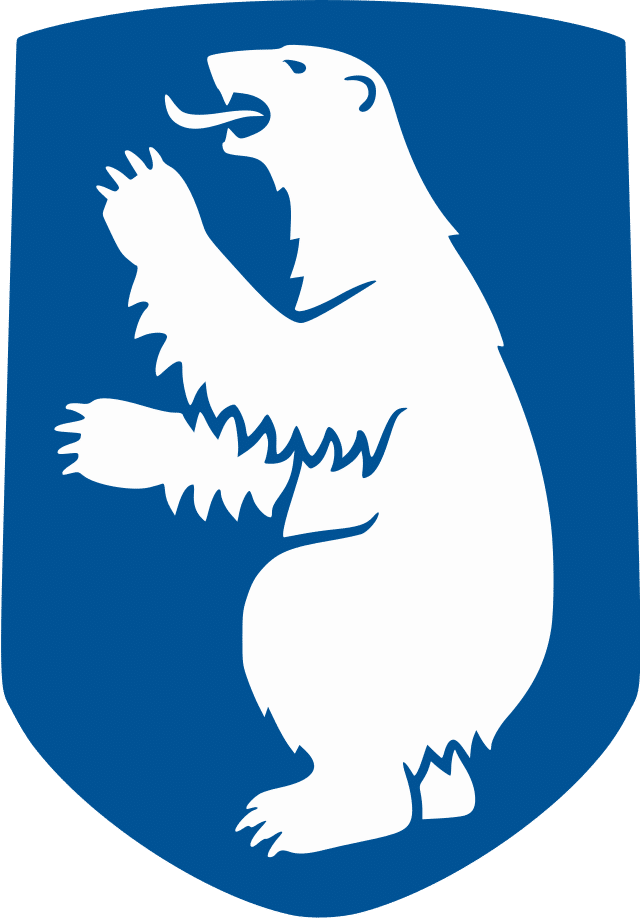Contents
Greenland, the biggest island in the world, is sandwiched between the Arctic and Atlantic Oceans. It is home to breathtaking scenery, thriving towns, and a rich cultural history. The Greenlandic flag is a potent symbol of the history, people, and ideals of the country.
If you’re interested in the meanings and interesting stories behind the flag’s design, colors, and symbolism, you’re at the right place. In this article, we’ll discuss the importance of the national Greenland flag and learn more about its hidden meanings.
Greenland: A Country Profile
Geographical Overview
Let’s start a review of the Greenland flag by exploring the country profile first. Greenland is the biggest island in the world and is situated in the northernmost region of North America. It is situated halfway between the Arctic and Atlantic Oceans. Approximately 2,166,086 square kilometers (836,330 square miles) of ice and glaciers cover the majority of the island. Its breathtaking vistas, which display the untouched splendor of the Arctic area, include towering icebergs, fjords, mountains, and grassland.
All year long, Greenland observes Greenland Standard Time (GMT-3). Coordinated Universal Time (UTC-3) is three hours ahead of this time zone. The fact that time in Greenland does not follow daylight saving time ensures that the time is constant all year round.

Overview of the Culture
Inuit people make up the bulk of Greenland’s modest population. The low population density and dispersed villages along the shore are caused by its distant position.
Greenland’s culture is strongly influenced by its Inuit background. Since ancient times, the island has been home to the Inuit people, who have adapted ingeniously and with perseverance to the severe Arctic circumstances. The Greenlandic people still value and heavily incorporate traditional activities into their everyday lives, including storytelling, fishing, hunting, and other forms of outdoor recreation. A vivid aspect of Greenlandic culture is art, especially carving and printing.
Even though Kalaallisut, the Greenlandic language, is the official language in the country, locals also speak Danish. In fact, in Greenland, you can feel the fusion of Inuit and Danish influences in many facets of daily life, including cuisine, music, and festivals.
Greenland’s National Day, observed on June 21, honors the island’s independence and is a time for patriotic fervor and cultural celebrations.
History of Greenland
Early Inuit Settlement
The first known residents of Greenland were the prehistoric Inuit people. These clever hunters and gatherers prospered in the harsh Arctic climate, creating advanced tools and survival tactics.
Norse Exploration
Erik the Red led a group of Norse explorers that found Greenland in the 10th century. As the first European colonies in the New World, they founded the Eastern Settlement and the Western Settlement. Before unexpectedly disappearing after many centuries, the Norse presence left behind remarkable archaeological relics.
Danish Colonization
Danish colonization started in 1721 when Denmark and Norway established a permanent settlement in Greenland. Initially, the colony concentrated on whaling, trading, and missionary activities.
Danish influence grew throughout time, causing cultural blending and social changes among the native people.
Home Rule & Self-Government
Greenland saw a considerable transition to self-governance throughout this century. Greenland was given home rule in 1979, giving the island more independence under the Danish Realm. Self-government was later established in 2009, giving the Greenlandic authorities responsibility over several domains, including justice and natural resources.
Design & Symbolism of Greenland Flag
The Greenland flag’s design is both aesthetically arresting and richly significant. With a white band at the top and a red band at the bottom, it has two horizontal bands of equal width. These hues have deep symbolic importance and capture the spirit of Greenland’s natural beauty and rich cultural heritage.
The color white on the flag is a representation of the immense expanses of ice and snow that make up Greenland. It represents pure Arctic nature, purity, and innocence. The white border also alludes to the country’s distinctive topography, which is shaped by icebergs and glaciers, inspiring awe and amazement.
Underneath the white band, the crimson band symbolizes the Greenlandic people’s fortitude, bravery, and resilience. It represents both their will to succeed in a difficult environment and their rich cultural heritage and history. They are reminded of their strong ties to the land, their ancestors, and the shared spirit by the striking red hue.
The breadth of the Greenland flag is twice as large as the height, giving it a 2:3 ratio. The composition is balanced and appealing to the eye thanks to this conventional ratio. The overall proportions and harmony of the flag’s size make it simple to identify and recognize it from a distance.
The Greenland flag has symbolic components that expand its significance beyond its colors and proportions. A circle referred to as a “Merki,” which stands in for the sun, is located at the hoist side of the white band. The circle represents the sun’s enduring presence in Greenland’s arctic area, where it shines for extended summer days and forges a unique atmosphere.
History Of Greenland Flag
The development of self-government and acknowledgment of the island’s unique cultural identity are strongly related to the history of the Greenland flag.
First Greenland Flag Design
On June 21, 1969, the Greenland flag’s initial design was unveiled. It was created by Greenlandic artist Thue Christiansen and included a blue backdrop with a white disk depicting the sun on it to reflect the island’s surrounding blue waters. When Greenland changed from a Danish colony to a Danish province, this pattern served as the country’s territorial flag.
As Greenland’s desire for more autonomy developed, a push to create a distinctive national flag that would set the island apart from Denmark started. A competition was organized to choose a new design, and on June 21, 1979, the chosen design was announced.

The First Territorial Flag
The Home Rule Government of Greenland formally approved the new Greenland flag on June 21, 1985. Thue Christiansen, a Greenlandic artist, and engineer who also created the first territorial flag, created the new flag. The adoption of this flag was a significant step in advancing our understanding of Greenland’s unique political and cultural identity.
An important step on Greenland’s journey to greater autonomy was the adoption of the Greenland flag. It served as a symbol of Greenland’s unique character and independence ambitions.
New Changes In 2009
On June 21, 2009, Greenland increased its autonomy from Denmark and obtained self-rule, marking a significant occasion in the history of the Greenland flag. The significance of the flag as a potent representation of Greenlandic independence and national pride was further cemented by this occurrence.
Greenland Coat Of Arms
The Danish colonial empire governed Greenland during the beginning of the 18th century, which is when the Greenland coat of arms first appeared. In 1747, a coat of arms particularly symbolizing Greenland was first portrayed.
A shield with four quarters was part of the initial coat of arms. The Danish royal bloodline was represented by a golden lion on a crimson backdrop in the first and fourth quarters. A silver polar bear wandering on a blue backdrop appeared in the second and third quarters, reflecting Arctic fauna and the distinctive natural landscape of Greenland.
The coat of arms style experienced several changes over time. The shield was reduced to a single quarter with a crimson background and a golden lion in the late 19th century.
A new coat of arms was adopted by Greenland in more recent years as a result of the country’s desire for increased acknowledgment of its distinctive political and cultural identity. A new version, created by Greenlandic artist Jens Rosing, was released in 1989. The current coat of arms depicts an Inuit-style boat with a white flag on top of a blue and white wave design that represents the surrounding waters.

Greenland Flag Protocol
The Greenland flag protocol specifies acceptable conduct when displaying and handling the country’s flag. Here are some essential rules:
- Official occasions, private houses, and public buildings should fly the Greenland flag. From dawn till dusk, it ought to be flown from a flagpole. The flag should be adequately lighted if flown at night.
- The flag may be flown at half-staff as a symbol of respect or to remember significant local, regional, or global occasions. The flag should be raised to the peak and then lowered to half-staff while flying at half-staff.
- The Greenland flag should be shown prominently and given special attention when numerous flags are flown at once.
- The Greenland flag should be positioned prominently and given priority over other flags when many flags are flown at once. The Greenland flag should be positioned to the right of any other national flags that are flying.
- The Greenland flag should be carried or displayed with respect during parades and processions. It ought to lead the way or be given a prominent role.
- The Greenland flag must always be handled with respect. It must never be used disrespectfully or in contact with the earth. It ought to be neatly folded and kept in a respectful way when not in use.
Bottom Line
The Greenland flag combines the country’s natural beauty, cultural legacy, and hopes for the future. It captures the spirit of this exceptional Arctic nation. Its arresting use of color and symbolism conveys a message of resiliency, solidarity, and the peaceful coexistence of humans and the environment.
The flag serves as a symbol of the collective identity of the Greenlandic people, representing everything from their spectacular ice and mountain landscapes to their rich cultural heritage.